Thatching Reed: supporting buildings and nature
Conservation, Materials, Vernacular and earth building | Written by: Guest | Thursday 31 August 2023
The Royal Society for the Protection of Birds (RSPB) have finished preparing another year’s harvest of thatching reed at their Tay reedbeds. But did you know harvesting reed for thatching also supports nature as well as building conservation?
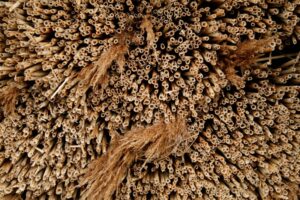
Close up of a stack of cleaned & trimmed Phragmites reed. Tay Reedbeds RSPB reserve. Near Perth, Scotland. February 2007. Credit: Andy Hay (rspb-images.com).
Thatch in Scotland
Thatched buildings, roofed with a variety of organic materials, were once a familiar sight across Scotland. These buildings varied in character and appearance depending on the materials that grew locally, and the type of weather the building had to cope with. Materials such as heather, broom, marram grass, rush, straw and bracken were all used as well as reed.

Cottage thatched with reed, Swanston Village, Edinburgh © Courtesy of HES (Society for the Protection of Ancient Buildings Collection)
It is estimated that less than 250 thatched buildings now survive. A combination of factors led to their disappearance across Scotland. The perishable nature of thatch, changes in land use, loss of thatching skills, and other roofing materials such as corrugated iron and slate becoming widely available, were all key factors in the decline of thatched buildings in Scotland.
Around 40% of our surviving thatched buildings are roofed with reed. The only commercial source of thatching reed in Scotland today are the Tay Reedbeds in Perthshire, managed by the RSPB. The harvest is in for this year and ready to go on roofs.
As well as providing an essential thatching material, reed cutting also plays an important role in conserving Scotland’s nature. We caught up with RSPB Tayside Reserves Warden Vicky Turnbull to find out more about the reedbeds and how they support both nature and building conservation.
Where are the Tay Reedbeds, and why are they special?
Vicky:
The Tay Reedbeds are the largest in the UK and stretch for around 11 miles between Perth and Dundee, along the north edge of the River Tay.
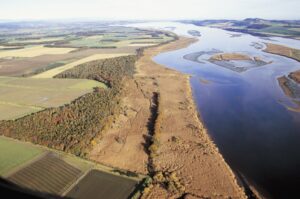
Tay Reedbeds RSPB reserve, Perthshire, Scotland. November 2004. Credit: Andy Hay (rspb-images.com).
They were originally established to protect the riverbank from erosion, and today they’re home to a rich array of wildlife. They’re part of the Inner Tay Site of Special Scientific Interest (SSSI), because of its habitats and bird life, including the beautiful bearded tit—a species which specialises in living in reedbeds and relies on them year-round.
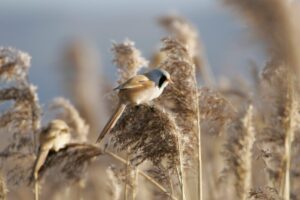
Male Bearded reedling Panurus biarmicus, feeding in Phragmites reed bed. Tay Reedbeds RSPB reserve. Near Perth, Scotland. February 2007. Credit: Andy Hay (rspb-images.com)
The reedbeds are also a stronghold for the Scottish population of breeding marsh harrier and hold a large number of the elusive water rail.
And of course it’s the only commercial source of reed for thatching in Scotland so we’re delighted to be able to support wildlife and built heritage at the same time.
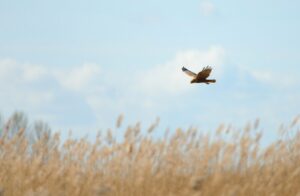
Marsh harrier in flight. Credit: (rspb-images.com).
Why does the RSPB cut the reed?
Vicky:
The reed has been used for various purposes historically, including livestock bedding and paper making. But the site has produced thatch commercially since the 1970s, which created a habitat for bearded tits to colonise. The reedbed now supports the largest population in the UK.
By the early 2000s, the large-scale commercial operation was no longer financially viable, and without management, the reedbed would become too dense for most species. They would lack diversity, resulting in species declines. So, the RSPB stepped in in 2005 to take over some of the reedbed. We reduced the size of the areas which were cut to create a mosaic which balances the ecological benefits with thatch production, to ensure we deliver the best habitat for wildlife as well as maintaining the cultural heritage of the site.
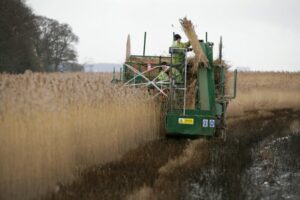
Graham Craig and John Logie harvesting reed at Tay Reedbeds RSPB reserve. The reed is cut and bundled using a Seiga reed harvesting machine, which moves through the reedbed on enormous ‘balloon’ tyres. Graham drives and operates the machine: cut reed is bundled and passed up a conveyor to John, who places the bundles in a cradle. Near Perth, Scotland. February 2007. Credit: Andy Hay (rspb-images.com)
How are the reeds cut?
Vicky:
The harvesting and management of the reedbeds takes place over the winter between November and March when the reed has stopped growing and the leaf has dropped off. To ensure the reed rhizomes (the root system of the reed, where the shoots come from) aren’t damaged, a tracked machine with low ground pressure is used to cut blocks within the reedbed and produce bales. This uses wide tracks and spreads the weight of the machine across a larger area which reduces the risk of damaging the rhizomes. This stage is weather dependent, which isn’t ideal over winter, as the reed cannot be cut when it’s wet.
A bale is made up of 80 smaller bunches. When two bales are cut, they’re stored to be collected later. All the bunches are then processed and cleaned to remove any leaves and broken reed to ensure a high-quality product. The whole process is very labour intensive, but then the thatch is ready to be sold to thatchers or homeowners, with one bunch able to cover one square foot of roof.
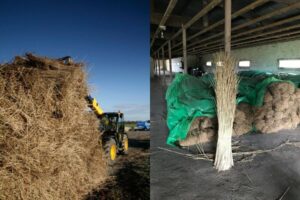
(L) Loads of cut reed are stacked, ready to be fed through a cleaning machine that Graham Craig devised & built himself. Near Perth, Scotland. February 2007. Credit: (rspb-images.com). (R) A bunch of harvested Tay reed. Credit: Crown Copyright.
Can people visit the reedbeds?
Vicky:
There is a path network near the reedbeds which people can use to access the reserve. The best starting point is Errol—from there you can head towards the river and join a footpath which follows the riverbank along the edge of the reedbed. People will get great views of the scale of the reeds and the river. But we advise people not to go into the reeds as there are some very deep gullies which are best avoided and we also want to avoid disturbing the wildlife as much as possible.
Do you have a favourite species that lives there?
Vicky:
We have three main bird species that we focus on, but I think water rail are number one for me. They’re so well hidden most of the time and difficult to spot, even when you can hear them calling their pig-like call from a few meters away. So, it always feels quite special when you actually get to see one. Plus, their chicks are like little black pom poms with long legs, which are even harder to see!

An adult water rail. Credit: (rspb-images.com).
To buy thatching reed, contact Vicky Turnbull, RSPB Tayside Reserves Warden.
Find out more about the Tay Reedbeds, or watch this video from the RSPB to find out more about how reedbeds are managed.
To learn more about thatch as a traditional building material download our publications, or explore our videos on thatch on our YouTube channel, including thatching with Heather and Marram Grass, and introduction to traditional roofs, and rethatching Arnold Blackhouse.
- Share this:
- Share this page on Facebook
- Share on X
About the author:
Guest
From time to time we have guest posts from partners, visitors and friends of the Engine Shed.
View all posts by Guest



